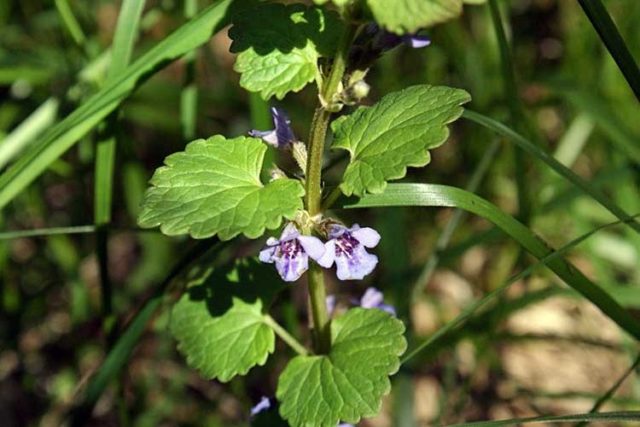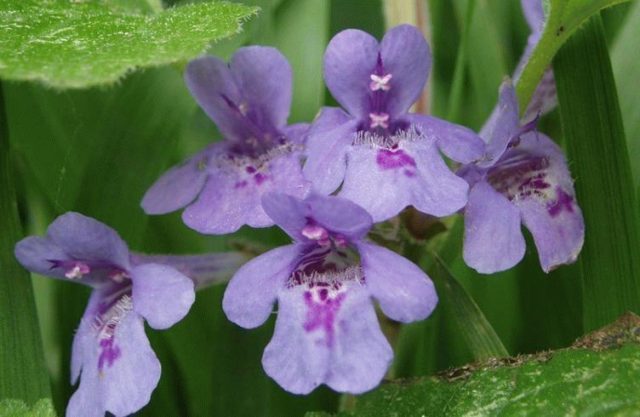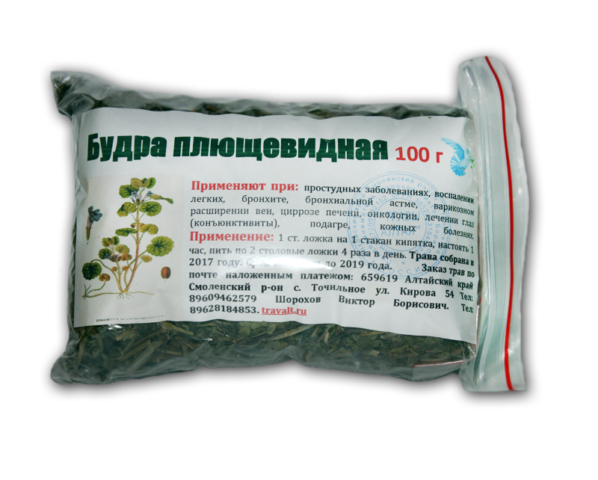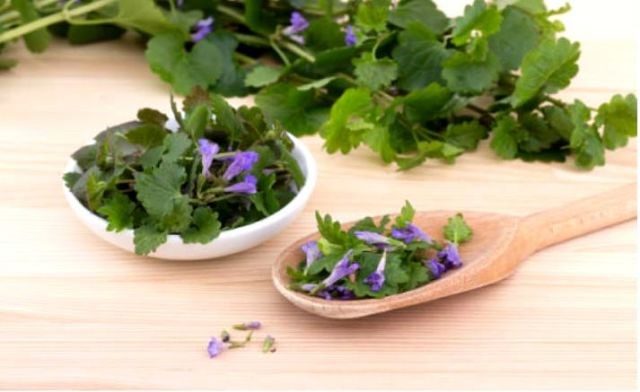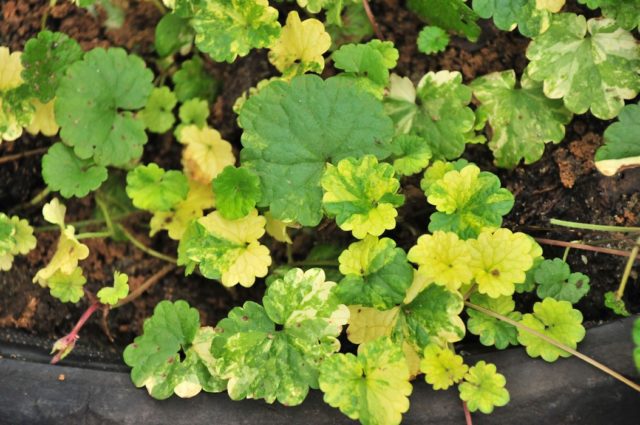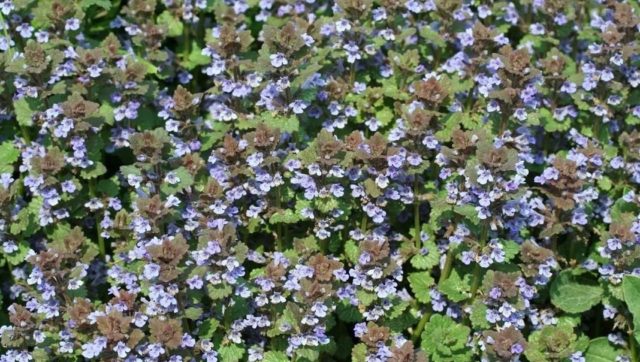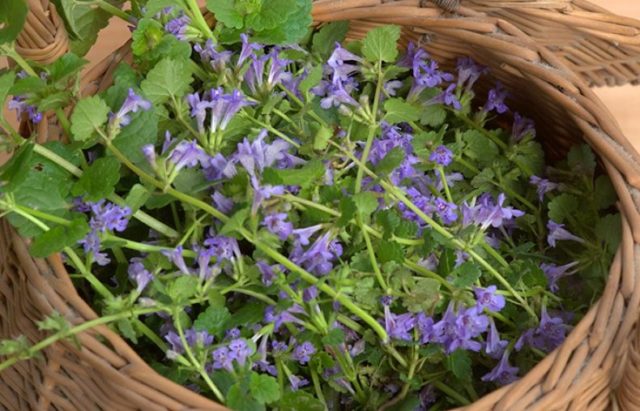Content
- 1 What does budra grass look like?
- 2 The healing properties of ivy budra
- 3 Application of dog mint
- 4 The magical properties of ivy budra
- 5 Planting and caring for budra
- 6 Growing and caring for ivy budra
- 7 Pests and diseases
- 8 How to get rid of ivy budra on the site
- 9 When and how to collect budra for medicinal purposes
- 10 Conclusion
Ivy budra (Glechomahederacea) is a species belonging to the genus Budra from the Lamb family. In the area, the grass can be a valuable groundcover or a bad weed. Sometimes it is grown in special beds or flower beds with medicinal crops, but more often it is harvested when weeding or while caring for the main plantings.
The culture also has other names that differ from those accepted in botany - Budra Ivy-shaped. Budra Creeping, Dog Mint, Sorokaneduzhnik, they are ubiquitous. Breast or Opukhov grass, Blyuschik, Garuchka are less known, or are used in a separate region.
What does budra grass look like?
Ivy budra is a perennial herb with leaves wintering under the snow and remaining green until spring. It got its name from the creeping and rapidly rooting shoots. Just like ivy, budra, under suitable conditions, assimilates large areas in a few years, displacing plants competing for water and nutrients. It covers not only the ground with a thick carpet, but also the fallen tree trunks.
Above the soil surface, the ivy-shaped budra rises no more than 15 cm, and then during flowering. Tetrahedral, slightly pubescent shoots are located in a horizontal area, able to take root at each node. Stems 15-20 cm long, rarely 50 cm long, strongly branched and slightly raised at the ends.
The leaves are opposite, that is, they come out of one node, and are arranged in pairs, symmetrically to each other, which is clearly visible in any photo of ivy budra grass. Their shape resembles a heart or a kidney, the edge is crenate with rounded denticles, the veins are clearly expressed. The size does not exceed 3 cm, the color is green, the petioles are of medium length.
Thin, fibrous roots break easily. But this has little effect on the general condition of the plant. Each node, touching the soil with sufficient moisture, takes root without separating from the mother bush, supplies it with water and nutrients.
Ivy buddra undergoes two bursts of growth of leaves and shoots per season. The first begins in early spring and fades away with the beginning of bud formation. After flowering, the aerial part again enters the phase of active development. It stops only with the onset of frost.
Where budra grows
Ivy budra grass grows practically throughout Eurasia in temperate zones up to the Far East. It is absent only in some areas of the Trans-Urals.The culture came to North America along with settlers; in the central and adjacent states of the United States, it is considered a malicious weed.
Ivy budra grows in meadows, forests and bushes, along river banks, in private plots, neglected vegetable gardens and farm fields. Dog mint makes its way even through the asphalt of megalopolises, mastering abandoned lawns, the area near fences and along the roadsides there. For culture, the main thing is that there is at least a little fertile soil and periodic watering.
When and how ivy budra blooms
Budra flowers are small, bisexual, tubular, 1-2.2 cm long, located in the middle or at the tops of the shoots. The corolla is two-lipped, violet-blue or bluish-lilac, the pharynx is often white, with dark strokes and specks. The upper part of the flower is short, split in two. The lower one is protruding, consists of four segments, with a bright purple spot in the middle. You can clearly see the structure of the dog mint flower in the photo.
The buds are collected in the leaf axils in 2-4 pieces. They open shortly after the beginning of the growing season - in April-May. Flowering is long, sometimes lasts until August. Dog mint fruits are prefabricated nuts, the seeds ripen by July-August.
What is the scent of dog mint
The smell appears if you damage or rub the sheet with your fingers. Sharp and specific, not everyone likes it. To be more precise, few people would call the aroma of ivy budra pleasant. It resembles a mixture of mint and sage.
Features of breeding budra
The plant propagates easily by self-seeding and takes root in the nodes as soon as they come into contact with the soil. You can breed dog mint yourself:
- layering;
- dividing the bush;
- planting green cuttings directly into the ground in spring or immediately after flowering;
- sowing seeds early in the season or before winter.
In order for the rooting of budra to be successful, it is enough to regularly water the planting. Cuttings will take root better in a slightly shaded place. As soon as new leaves appear, the dog mint can be repotted.
The healing properties of ivy budra
The medicinal properties of dog mint are due to the large amount of nutrients contained in the aerial part of the plant:
Name | Maximum content |
tannins | 7,5% |
essential oils | 0,6 |
free amino acids: methionine cysteine serine |
0,29% 0,12% 0,06% |
vitamin C | 32 mg% |
choline | 8.2 mg% |
In addition, the plant contains caffeic and resin acids, gum. Budra contains 35 trace elements, the main of which are:
- phosphorus;
- manganese;
- titanium;
- copper;
- zinc.
What diseases does Budra help against?
In Western Europe and America, dog mint is recognized as an official medicine and is used to treat:
- bronchial asthma;
- skin diseases;
- liver, including hepatitis;
- thyroid gland;
- pneumonia;
- gallbladder;
- urolithiasis.
In the post-Soviet space, you can find dog mint as part of imported medicines, brought in privately, or dietary supplements. Officially, the budra plant hanging in Russia is not a medicinal plant.
Application of dog mint
Although ivy budra is better known to herbalists and landscape designers, nevertheless, the culture has found application in other areas. She was not ignored by culinary specialists and winemakers, esotericists and cosmetologists.
In folk medicine
Domestic medicine does not study the medicinal properties and contraindications of Budra herb, but the culture is well known to folk healers. It is not for nothing that they call her a magpie.Healers include the herb in their collections and use it on their own to fight many diseases. Dogmint is considered to be a remedy for:
- expectorant;
- diuretic;
- antiparasitic;
- gastric;
- relieves inflammation;
- anti-sclerotic;
- lowering blood sugar;
- choleretic;
- pain reliever;
- antineoplastic.
Traditional medicine treats chronic diseases of the upper respiratory tract, prostatic hyperplasia, accompanied by sputum, with the help of ivy budra. For wounds, skin problems, gout, lotions and baths are recommended.
Recipes for decoctions and infusions with ivy budra
For medicinal purposes, the entire aerial part of dog mint is used. Sometimes juice is squeezed out of the grass and, for example, 1-2 drops are instilled into the nose for a headache. But more often decoctions and infusions are prepared from Budra:
- For diseases of the liver, gastrointestinal tract, upper respiratory tract, a teaspoon of fresh dog mint grass is crushed, poured into a glass of boiling water. Insist until the liquid cools down. They are filtering. Take 1/4 cup warm 2 to 4 times a day.
- For the same diseases, as well as tuberculosis and cystitis, an infusion of dried herb budra will help. A tablespoon of crushed raw materials is poured with 3 cups of boiling water. Insist 60 minutes. Take 2 hours before meals, 2 tbsp. l. no more than 4 times a day.
- A decoction of dry herb budra will help in the treatment of goiter, liver and biliary tract, lung diseases. A teaspoon of raw materials is poured into a glass of boiling water and heated for 15 minutes in a water bath. Insist 45 minutes. Warm strained broth is taken before meals for a quarter of a glass no more than 4 times a day.
- For diseases of the liver, bladder and bronchial asthma, you can use an infusion of Budra on alcohol (40%) or vodka. Dry grass and alcohol are mixed in glass containers 1:10, kept in a dark place for 10 days. Take 15 drops three times a day before meals.
- Suppuration, rashes, dermatoses, boils will help to cure lotions and washing the affected skin with a decoction of budra. Bring a tablespoon of dog mint to a boil with a glass of water. Wrap up and leave to cool.
- Expectorant collection. Chopped fresh or dry herbs are mixed in equal proportions: budru, cocklebur, hoof. A tablespoon of the collection is thrown into a glass of hot water, brought to a boil. Keep on fire for 3 minutes, insist for half an hour. Drink 3 times a day after meals.
- The scabies mite is a very nasty skin parasite. You can get rid of it if you rub a strong tincture of budra in vinegar into the affected areas 2 times a day.
- For pneumonia, collecting from dog mint, poplar buds and elder flowers in a ratio of 2: 2: 1 will help. 5 tablespoons of the mixture are poured with 3 cups of boiling water. Insist, filter, drink during the day.
- Pharyngitis can be cured if 1 tsp. pour a glass of boiling water over blossoming budra and insist. Use for hot inhalation or rinsing.
Tincture on budra for cancer
Dog mint cannot be used as an independent remedy for cancer. The patient must undergo a full-fledged drug treatment. As an aid, the herb may only be taken after consulting a doctor. The tannins and other substances contained in ivy bud can block or alter the effect of drugs.
The plant is not recognized by official medicine, so the doctor is unlikely to include it in the treatment process. You can use Budra on your own only if there is no direct prohibition on it.
Traditional medicine believes that dog mint can provide relief from leukemia and liver cancer. There are two ways to take the herb:
- Broth. Prepare it in a water bath in the same way as for the treatment of goiter, liver and pulmonary diseases: 1 tsp. dry herbs budry pour a glass of boiling water and keep in a water bath for 15 minutes. Insist for an hour, drink warm 3-4 times a day before meals.
- Dogmint infused for 10 days in 40% alcohol (1:10) is taken 3 times a day, 12-20 drops, diluted with a small amount of water.
Limitations and contraindications
Ivy budra, the medicinal properties of which are undoubted, belongs to moderately poisonous plants. Here you can recall Paracelsus, who argued that the difference between a medicine and a poison lies in the dosage. For example, the ivy-shaped bud, toxic to the liver, is much less than in the peppermint and marsh mint, which are considered quite safe.
Essential oils and bitterness can irritate the kidneys and gastrointestinal tract. Dog mint infusions and decoctions should not be used uncontrollably or exceed the recommended doses. It is not recommended for ulcers to drink them on an empty stomach.
The first sign of poisoning with ivy budra is increased salivation, sweating. Then cardiac activity, blood clotting may be disturbed, pulmonary edema may occur.
Among the direct contraindications for Budra:
- low acidity;
- tendency to form blood clots;
- age up to 3 years;
- pregnancy and lactation;
- renal or hepatic impairment.
In cooking
Sometimes fresh young leaves of ivy budra are put in salads. Here you need to know when to stop and not make the herb the main ingredient.
Dogmint is used in brewing and for flavoring kvass. In addition to imparting additional bitterness and odor, the herb helps to increase the shelf life of drinks.
As a spicy-aromatic additive to meat and barbecue marinades, Budra not only improves the taste of the finished dish. It promotes the absorption of fats.
In landscape design
The herb for open ground ivy budra in landscape design is more represented by an ornamental variety with white-bordered leaves Variegata. Unlike the maternal form, the variety is not so undemanding to growing conditions. With a sunny location and scarce watering, especially in the south, the foliage of the budra burns out, and it is difficult to preserve decorativeness.
There is a rare Russian variety Zolotoy Oktyabr, less capricious than Variegata. Many people like him outwardly much more. Dogmint leaves are covered with irregular yellow spots. Their color, as seen in the photo of the ivy-shaped Golden October budra, is especially intense in autumn.
Dog mint is used as a ground cover plant. In large areas, it fills in the voids between trees and shrubs. Variegated ivy buddras are planted in irrigated flower beds and ridges.
Where else can dog mint be used?
In cosmetology, ivy budra is used as part of masks and ointments for acne or other skin rashes. In phoniatrics, plants are sometimes used to treat persistent coughs.
In the garden, dog mint is used to turf tree circles. On strawberries, plants protect each other from pests with their secretions. There are other benefits as well:
- ivy budra prevents the berries from falling on the soil;
- strawberries protect dog mint from the bright sun.
The magical properties of ivy budra
Dognip is called witch herb. It is believed that she frees from curses, love spells and any other dark influences. Esotericists claim that the plant cleanses and restores the human aura.
But dark magicians also use ivy-shaped budra. The grass can unite together people, broken ties, the powers of sorcerers during sorcery. This property is used for their own purposes, both evil and good forces.
Planting and caring for budra
The species ivy budra as a herb for open ground requires very little care. A little more trouble will be the Variégata variety. Golden October is rare, but, according to reviews, it is as unpretentious as a wild plant.
Dog mint takes root well, no matter how it was planted - from a container, with an open root, seeds or cuttings. It is important for the first time to water the budra regularly, and choose the land at least a little fertile.
The offspring of the species dog mint planted in spring will quickly grow in all directions, and by autumn they will cover a significant area. With the Variegata variety, this will not happen so quickly, he needs to provide moderate regular watering.
Ivy buddha is planted in the sun or in partial shade. No special precision is required when placing dog mint - it will spread in all directions in less than a season. The bushes are planted the thicker, the faster you need to cover the ground.
Growing and caring for ivy budra
Dog mint does not require top dressing, being content with what it got when caring for neighboring plants. Only the shoots that have spread or have lost their decorative effect due to overdrying are cut off. No shelter is required for the winter.
Weeding and mulching of the soil is not carried out. Dogmint will spread so much a year after planting or even at the end of the first season that it can protect the roots of large plants from overheating and moisture loss.
Itself, being a malicious weed, budra does not allow to grow and "survives" from the site of competitors. So small ornamental plants with a superficial root system need to be monitored - they will not withstand independent competition with a dog.
Possible growing problems
Ivy budra is a plant that is resistant to external influences, which is much easier to start on the site than to expel from there later. There is only one problem with a species of dog mint - it cannot be completely eradicated.
Budra grows worst of all on poor sandy and constantly blocking or dry areas. The white-bordered form needs more light and water than the specific dog mint.
From excessive watering, all parts of the plant will rot. In the south, without irrigation in hot summer, the roots cannot get enough moisture, for which reason the leaves near the budra dry.
Pests and diseases
Dog mint is sick and affected by pests only in exceptional cases. From waterlogging, the root and stem of the budra can rot. When kept dry, in addition to wilted leaves, a spider mite appears on the plant.
How to get rid of ivy budra on the site
Dogmint is a difficult weed to get rid of. But it must be removed from the garden without fail. If you leave the budra on an area where farm animals graze, they can get poisoned and even die.
To combat budra:
- in the spring, soil treatment with herbicides is used; on lawns and pastures, you can use selective drugs, for example, Lintur;
- the beds are mulched with non-woven materials, straw or mown grass;
- carry out weeding.
Dislikes dog mint and regular mowing. So it can be, if not completely removed from the site, then significantly reduce the contaminated area, stop further spread.
When and how to collect boudra for medicinal purposes
Unlike other medicinal herbs, dog mint can be harvested throughout the growing season. The aerial part - leaves, shoots, flowers - has healing power.
Most of all useful substances contain ivy budra, which was collected in hot dry weather. The shoots of the plant are lifted and cut with a knife or scissors.
How to dry and store dog mint properly
It is impossible to dry the buddha under a hot roof or in another room adapted for the rapid removal of moisture from plants or products. Essential oils contained in dog mint evaporate at temperatures above 30 ° C.
The ivy-shaped bud is spread in a thin layer on white paper (newspapers cannot be taken). Leave in the shade with good ventilation. As soon as the top layer dries, the grass is gently turned over to the other side. Do not stir and stir dog mint.
You can store dry grass at room temperature in sealed jars or cardboard boxes for no more than 1 year.
Conclusion
Many people know ivy budra, like a malicious weed. But it is also a ground cover and medicinal plant, an odorant for kvass or beer, a seasoning for meat. Before removing dog mint from a site, you need to think - what if there is a use for it.

